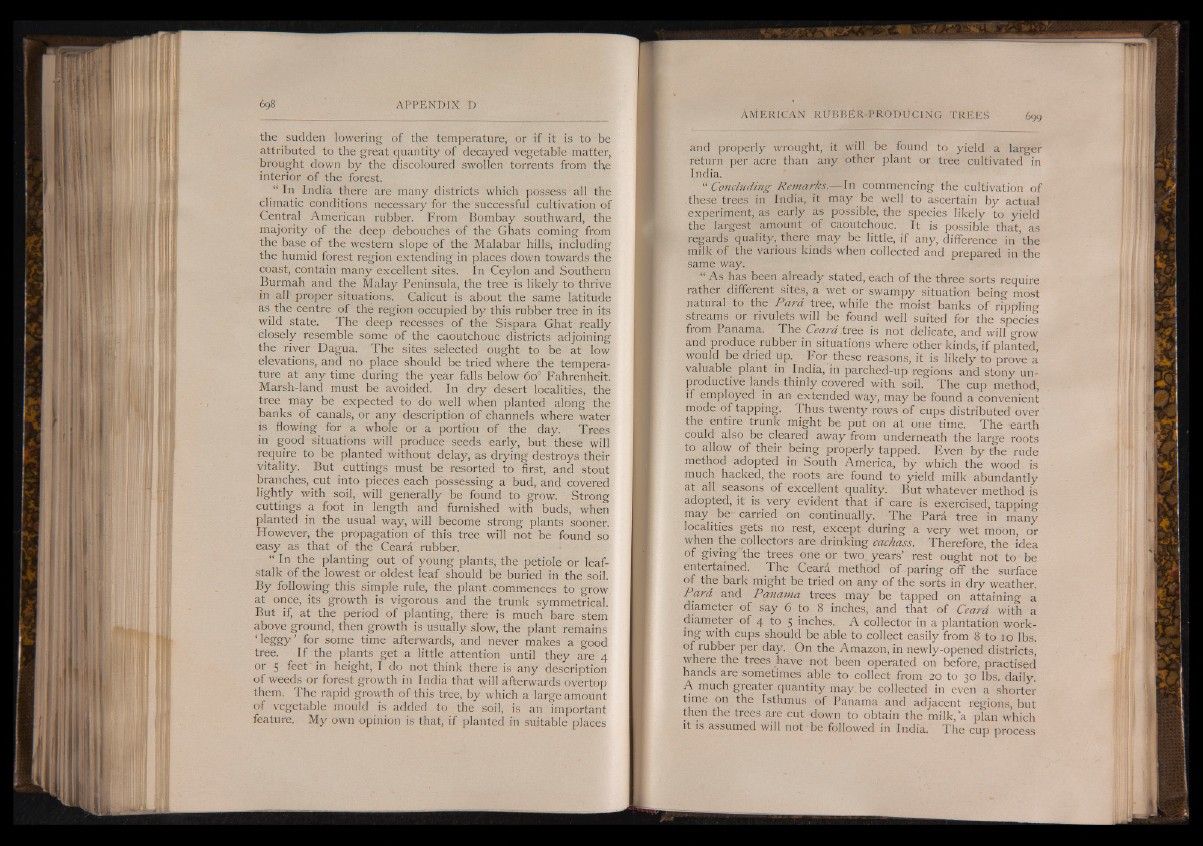
the sudden lowering of the temperature, or if it is to be
attributed to the great quantity of decayed vegetable matter,
brought down by the discoloured swollen torrents from the
interior of the forest.
“ In India there are many districts which possess all the
climatic conditions necessary for the successful cultivation of
Central American rubber. From Bombay southward, the
majority of the deep debouches of the Ghats coming from
the base of the western slope of the Malabar hills, including
the humid forest region extending in places down towards the
coast, contain many excellent sites. In Ceylon and Southern
Burmah and the Malay Peninsula, the tree is likely to thrive
in all proper situations. Calicut is about the same latitude
as the centre of the region occupied by this rubber tree in its
wild state. The deep recesses of the Sispara Ghat really
closely resemble some of the caoutchouc districts adjoining
the river Dagua. The sites selected ought to be at low
elevations,, and no place should be tried where the temperature
at any time during the year falls below 60° Fahrenheit.
Marsh-land must be avoided. In dry desert localities, the
tree may be expected to do well when planted along the
banks of canals, or any description of channels where water
is flowing for a whole or a portion of the day. Trees
in good situations will produce seeds early, but these will
require to be planted without delay, as drying destroys their
vitality. But cuttings must be resorted to first, and stout
branches, cut into pieces each possessing a bud, and covered
lightly with soil, will generally be found to grow. Strong
cuttings a foot in length and furnished with buds, when
planted in the usual way, will become strong plants sooner.
However, the propagation of this tree will not be found so
easy as that of the Ceara rubber.
“ In the planting out of young plants, the petiole or leafstalk
of the lowest or oldest leaf should be buried in the soil.
By following this simple rule, the plant-commences to grow
at once, its growth is vigorous and the trunk symmetrical.
But if, at the period of planting, there is much bare stem
above ground, then growth is usually slow, the plant remains
‘ leg g y ’ for some time afterwards, and never makes a good
tree. I f the plants get a little attention until they are 4
or 5 feet' in height, I do not think there is any description
of weeds or forest growth in India that will afterwards overtop
them. The rapid growth of this tree, by which a large amount
of vegetable mould is added to the soil, is an important
feature. My own opinion is that, if planted in suitable places
and properly wrought, it will be found to yield a larger
return per acre than any other plant or tree cultivated in
India. .
“ Concluding Remarks.— In commencing the cultivation of
.these trees in India, it may be well to ascertain by actual
experiment, as early as possible, the species likely to yield
the largest amount of caoutchouc. It is possible that, as
regards quality, there may be little, if any, difference in ’the
milk of the various kinds when collected and prepared in the
same way.
“ As has been already stated, each of the three sorts require
rather different sites, a wet or swampy situation being most
natural to the Para tree, while the moist banks of rippling
streams or rivulets will be found well suited for the species
from Panama. The Ceard.tree is not delicate, and will grow
and produce rubber in situations where other kinds, if planted,
would be dried up. For these reasons, it is likely to prove a
valuable plant in India, in parched-up regions and stony unproductive
lands thinly covered with soil. The cup method,
if employed in an extended way, may be found a convenient
mode of tapping. Thus twenty rows of cups distributed over
the entire trunk might be put on at one time. The earth
could also be cleared away from underneath the large roots
to allow of their being properly tapped. Even by the rude
method adopted in South America, by which the wood is
much hacked, the roots are found to yield milk abundantly
at all seasons of excellent quality. But whatever method is
adopted, it is very evident that if care is exercised, tapping
may be-carried on continually. The Para tree in many
localities gets no rest, except during a very wet moon, or
when the collectors are drinking cachass. Therefore, the idea
of giving the trees one or two years’ rest ought not to be
entertained. The Ceara method of paring off the surface
of the bark might be tried on any of the sorts in dry weather.
Para and Panama trees may be tapped on attaining a
diameter of say 6 to 8 inches, and that of Ceard with a
diameter of 4 to 5 inches. A collector in a plantation working
with cups should be able to collect easily from 8 to 10 lbs.
of rubber per day. On the Amazon, in newly-opened districts,
where the trees have not been operated on before, practised
hands are sometimes able to collect from 20 to 30 lbs. daily.
A much greater quantity may. be collected in even a shorter
time on the Isthmus of Panama and adjacent regions, but
then the trees are cut down to obtain the milk,’a plan which
it is assumed will not be followed in India. The cup process